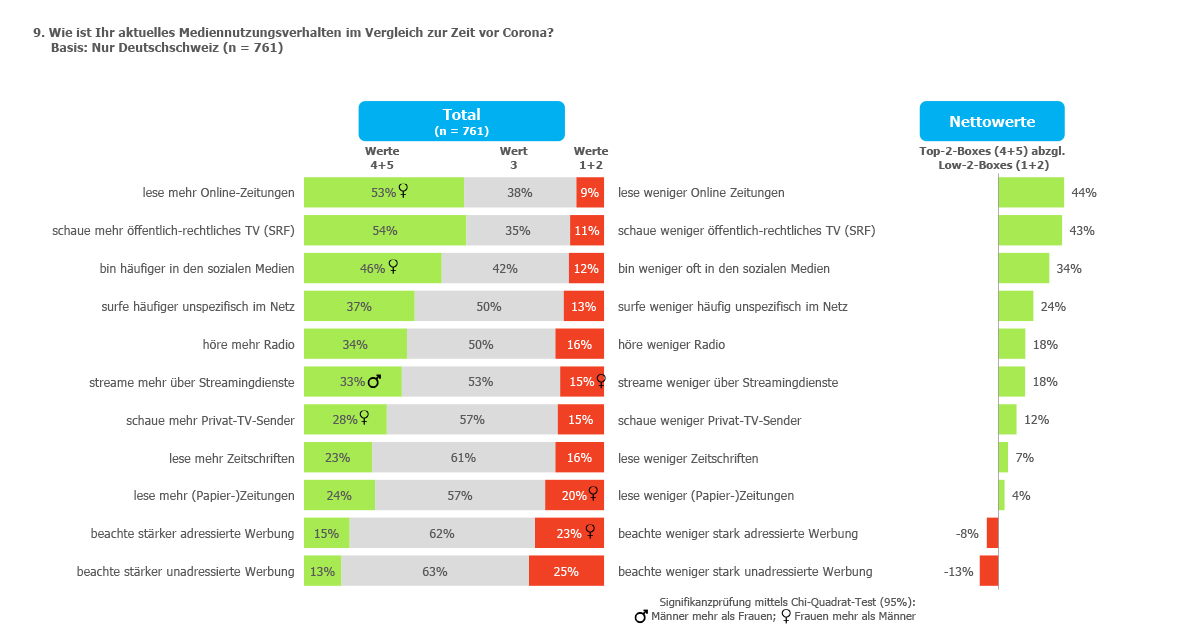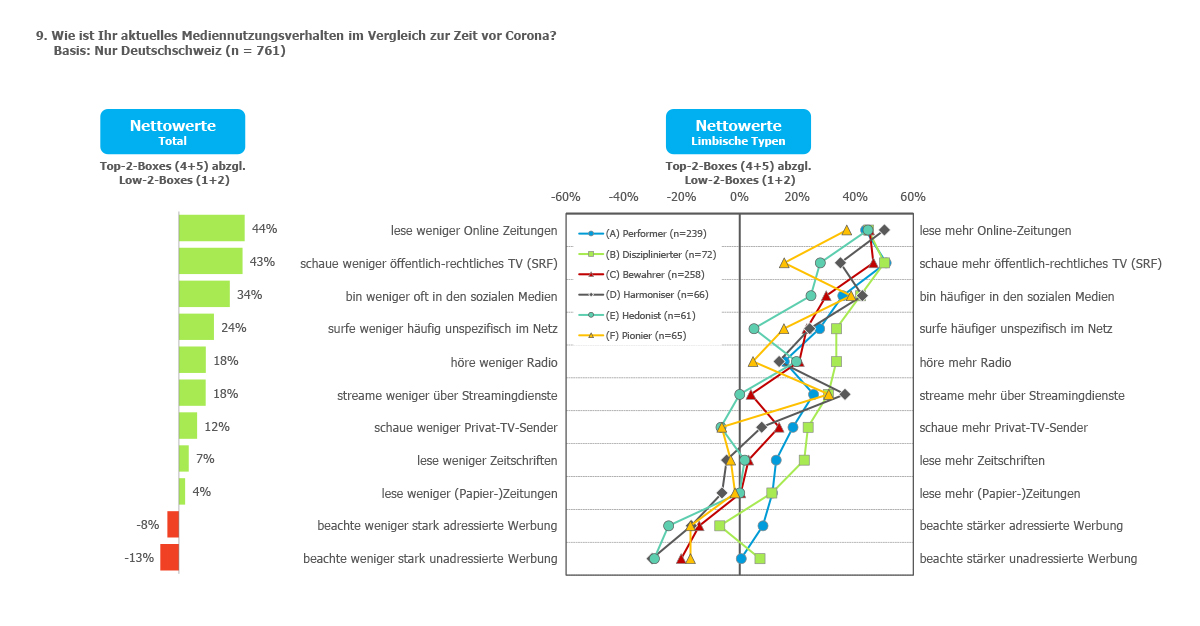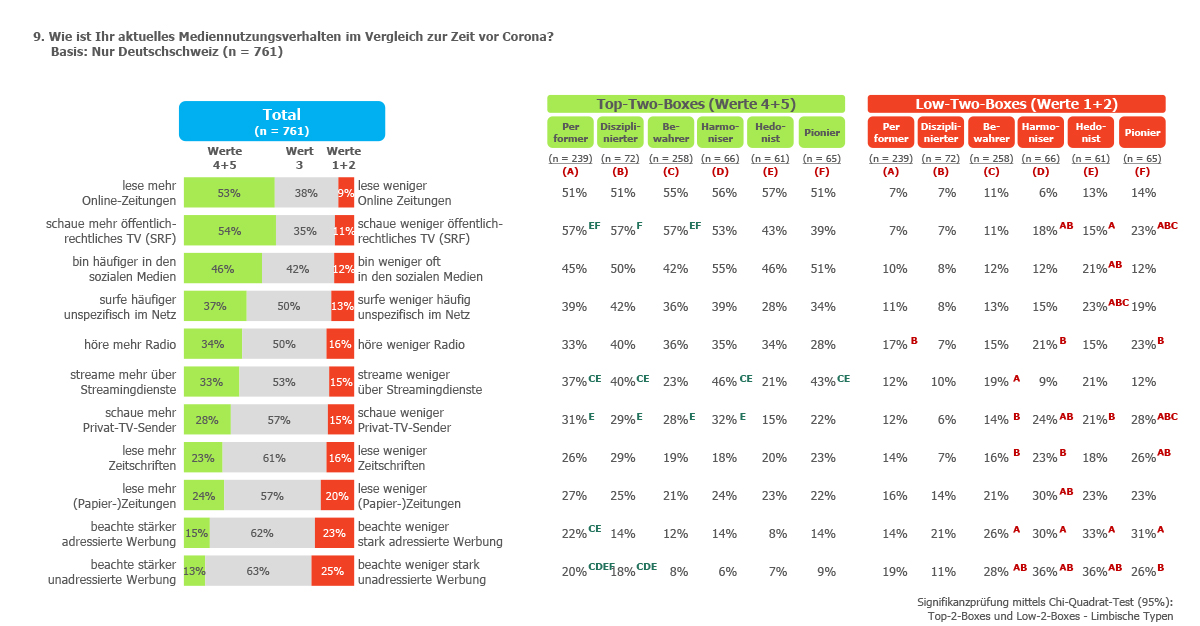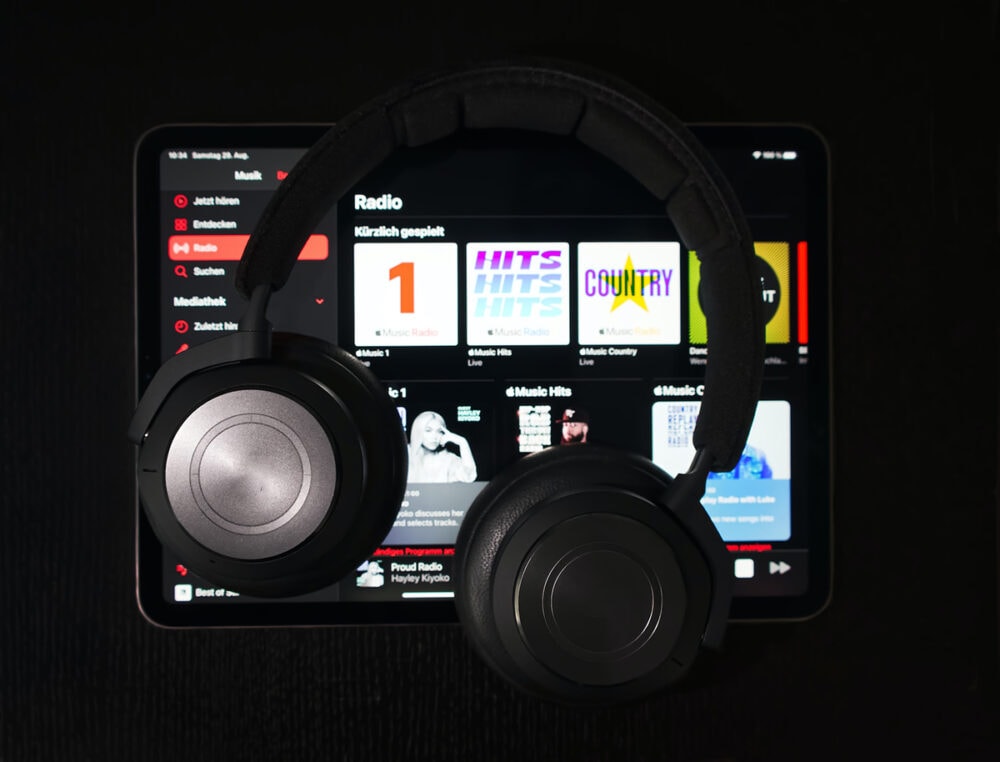How the Corona Crisis Affects Information Behavior
The Corona crisis influences the information behavior of Mr. and Mrs. Swiss. The representative, neuroscientific online study "Corona and Media Use" by independent market researcher Ursula Kaspar sheds light on which media increased in use during the crisis and who lost audience, as well as the role of the limbic system in this process.

In times of crisis, the advertising and media industries have a hard time, as budgets in these areas are almost reflexively the first to be cut. The current study by Ursula Kaspar aims to show why anti-cyclical advertising is worthwhile these days, because various media brands and channels have seen a significant increase in usage since the start of the Corona crisis. This can be explained by the fact that our general need for information is influenced by the current situation, and media consumption has also become more important for spending time at home.
24 Media brands were consumed more frequently in some cases
Of 39 media brands surveyed, 24 were consumed significantly more frequently during the crisis than before the crisis. The frontrunner - used more frequently by 37 percent of the population in net terms - is SRF 1, ahead of 20 Minuten (35%) and SRF Info (30%). Regional newspapers (20%), the Migros Magazine (16%), the Coop Newspaper, SRF 2 and View (15% each), RTL (14%), Pro 7 (13%), various regional TV stations as well as Radio SRF 3 (12% each), Radio SRF 1 (11%) and local radio stations (10%) made the biggest gains.
Slightly lower net growth was shown by Sat 1 (9%), VOX (8%), local newspapers and the Tages-Anzeiger (6% each), 3+ (5%), Watson (4%), Energy (3%), NZZ and K-Tip (2% each) and the Observer (1%). In particular, Sunday newspapers, business media and specialty radio stations lost net audience share during the crisis.

Online media and TV top
When asked which media channels are now used more frequently by Mr. and Mrs. Swiss compared to "before Corona," public television, online newspapers and social media can clearly count themselves among the winners. When we look at which communication channels were used more frequently during the crisis, online newspapers are at the top of the list with a net increase in usage of 44 percent.
This is closely followed by public TV (SRF) (43%) and social media (34%), non-specific web surfing (24%), radio and streaming services (18% each) and private TV (12%), magazines (7%) and paper newspapers (4%). Addressed advertising (-8%) and unaddressed advertising (-13%) attracted less net attention than before the crisis.

Values and motives influence usage behavior
According to the aforementioned study results, the environment for paid media - whether online or in paper form - is significantly tougher than for free newspapers or radio and TV with automatic fee collection. This development can be explained from a neuroscientific perspective. Namely, an online paywall subconsciously activates the "punishment center" in our brain, and a physical purchase in a store manifests itself in our subconscious as a "danger" during the crisis, which negatively influences the desire to buy.
Around 90 to 95 percent of all decisions are made in the part of the brain that works unconsciously, the limbic system. The limbic system is responsible for emotions and influences our motives and values. It explains why human views, insights and memories sometimes differ so greatly - as does media usage behavior.
An analysis of media usage and users on the basis of a limbic motive and value structure shows, for example, that Sunday or business newspapers were nevertheless used more frequently by their limbic core target groups than before the crisis, despite poorer values overall. This can play an important role in the battle for advertisers in the "appropriate limbic target group". But how is such a limbic target group defined?
Three basic instructions influence human behavior
Generally important is that information which either indicates a threat, promises a reward, or is new and therefore needs a risk check. What someone perceives as reward, threat or novelty depends on one's own personality profile as well as individual experiences and imprints - which is influenced by the limbic system.
Three basic instructions of the limbic system underlie our personality: The Balance-Instruction wants to avoid fear, uncertainty and change, needs security, constancy and community. The Dominance-instruction strives for power, autonomy and territory expansion, using struggle, prestige and oppression. The Stimulant-instruction seeks changes, surprises and new things, and takes risks to do so.
Six limbic types
The expression and interaction of the basic instructions are different for each person. However, the Institute for Limbic Communication has identified six simplified cluster types for daily research and communication work: Preserver (with high balance instruction), Performer (high dominance), Hedonists (high stimulus) and the intermediate types Disciplined (high balance and high dominance), Pioneers (high dominance and high stimulus) and Harmoniser (high stimulus and high balance). Certain basic values and motives are attributed to each limbic type.

Individuals with profiles opposite each other in the hexagon have strongly divergent to opposite motive and value structures; profiles lying next to each other have common values.
If media use and users are analyzed on the basis of the limbic motive and value structure, differences from the basic segmentation explained earlier become apparent. Online newspapers, for example, were read more frequently by 53 percent of the population, but without significant differences between the limbic types.
Public TV: Growth among performers, disciplinarians and preservationists
For public television (net +54%), however, exciting differences emerge: performers (high dominance), disciplinarians (high dominance and balance), and preservers (high balance) watched public television significantly more often than hedonists (high stimulus) and pioneers (high stimulus and dominance).
With its programs, public TV appeals in particular to the traditionally oriented balance audience, which makes up the largest part of the population in Switzerland. Based on their characteristics, this audience group wants to avoid fear and uncertainty, needs stability, security and constancy. Fear - especially of diseases, viruses and germs - thus spurs their media interest.
The dominance audience, on the other hand, is fundamentally much more media-savvy than other limbic types and, based on their value and motive structure, is particularly interested in the political, economic, and financial implications of Covid 19 measures.

Significant decrease in stimulant individuals
The highest proportion of those people who consume almost all media less often during the crisis than before are those with high stimulant content. Since variety and the desire for novelty are an important part of their personality structure, and stimulant individuals are generally less anxious than limbic types with a high balance content, corona themes can only encourage them to consume more media in the short term.
Nevertheless, to survive the constraints and monotony of self-quarantine, Pioneers (high Dominance and Stimulance) and Harmonizers (high Balance and Stimulance) are among the populations that use streaming services the most, especially more often than Preservers and Hedonists. However, the selection of streamed series and movies is likely to differ greatly between Harmonizers and Pioneers due to their contrasting personality structures.

Media brands under the limbic magnifying glass
Newspapers and magazines were read significantly more frequently by performers (dominance) and disciplinarians (dominance-balance) during the crisis than by preservers (balance), harmonizers (balance-stimulance) and hedonists (stimulance). Here, too, the explanation for the increased interest lies in the performers' need for information on the economy, politics and finance. Disciplined people additionally seek fact-based Covid 19 background reports due to their high balance proportion and the resulting fear of diseases and viruses.

Paywall as punishment
Paid newspapers and magazines suffer particularly. This is because - as already indicated - a paywall activates the "punishment module" in the brain, which has a particularly negative effect on usage among people with high balance instruction - the largest population group. These individuals orient themselves to free media because of its easy availability.
Nevertheless, there is a small consolation for certain paid newspapers and magazines: They were also able to make some gains in the core limbic target groups interested in media, which is a good advertising argument for customers with suitable limbic target groups.
- At the Sunday newspaper (net -2%), Hedonists (-19%), Pioneers (-15%) and Preservers (-8%) in particular reduced their consumption. Performers (net +12%), however, read newspapers more frequently than all other limbic groups.
- Finance and economy (net -3%) is read more frequently by performers (net +5%), and significantly less frequently by preservers (-11%).
- The NZZ on Sunday (net - 4%) is read more frequently by performers (+11%) and hedonists (+3%). Preservationists consume this newspaper less frequently (-6%).
The representative study "Corona and Media Use." was conducted by independent market researcher Ursula Kaspar together with the Institute for Limbic Communication among 761 people between the ages of 14 and 69 in German-speaking Switzerland. The interviews were collected via online survey between March 31 and April 7, 2020.








